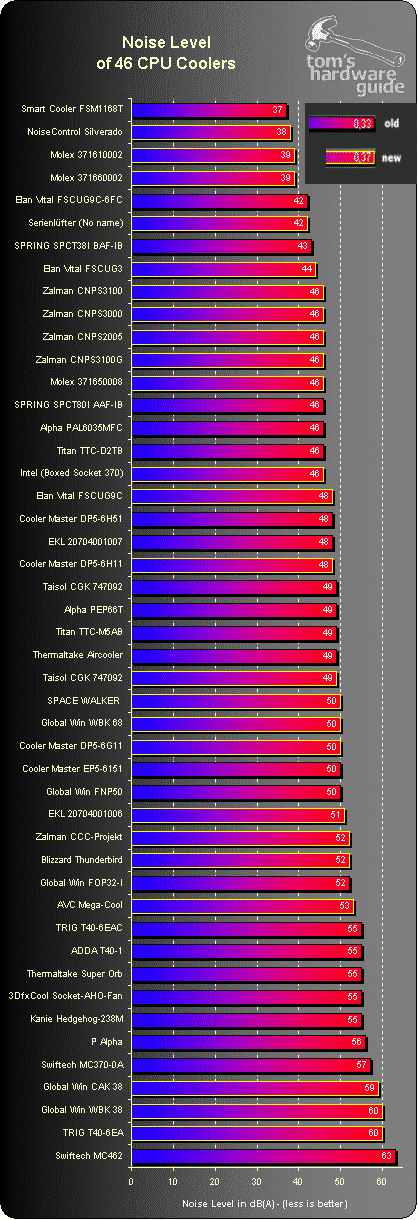Can't Touch This! A Comparison of 46 CPU Coolers
Noise Level - Is That A Construction Site Or An Office?

The Smart Cooler's score of 37 dB (A) is by no means positive - it is the cooler with the worst cooling performance of all 46 coolers tested.
While the Silverado from Noise Control was the quietest cooler in the last group tested, the newcomers have changed the rankings somewhat, even if the change is of no practical consequence. Although the Smart Cooler can serve up an operating noise level of a mere 37 dB (A), it still scores last in cooling performance among a total of 46 coolers. This allows the Silverado from Noise Control to hang onto the lead, since it offers very high cooling performance in addition to low noise. The Silverado's design with its encapsulated construction remains in a class by itself. Among all the Johnnys-come-lately, there's not a comparable cooler that's even close to the Silverado. Although the Molex cooler's design is relatively innovative and it can serve up a low noise level, its scores in the more crucial area of cooling performance are rather disappointing.
In general, a background noise rating between 35 dB(A) and 38 dB (A) is a great result, considering that the majority of the coolers tested produces 50 dB(A) of sound.
There is a scattering of new additions to the group of the noisiest coolers - the TRIG T40-6EA and the Global Win WBK 38 generate a noise level of 60dB(A), which puts them in direct violation of official guidelines governing health and safety in the workplace. This high noise level can be slightly reduced by using an appropriate case. According to readings we took of a standard PC case, however, the level doesn't drop below 55 dB(A). This makes the coolers too loud to install in a PC at the office. In general, one thing can be said about the noise level - each person's perception of noise level is subjective and hence different from the next person's. Be that as it may, noise levels above the 50 dB(A) limit are always disruptive, no matter what range of frequencies create them. Noise levels below 45 dB(A) are generally acceptable (depending on the frequency) and are perceived as less disruptive by the majority of people.
Stay On the Cutting Edge: Get the Tom's Hardware Newsletter
Join the experts who read Tom's Hardware for the inside track on enthusiast PC tech news — and have for over 25 years. We'll send breaking news and in-depth reviews of CPUs, GPUs, AI, maker hardware and more straight to your inbox.
Current page: Noise Level - Is That A Construction Site Or An Office?
Prev Page Cooling Temperature: Range From 30°C To 56°C Next Page A Real Heavyweight - Swiftech's 789 Grams!Most Popular



